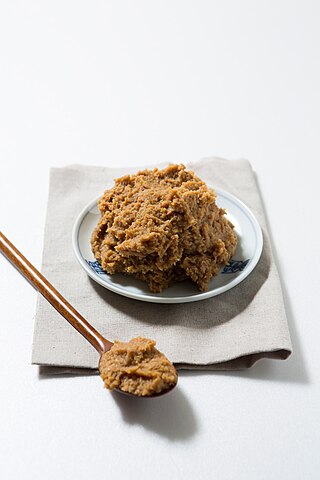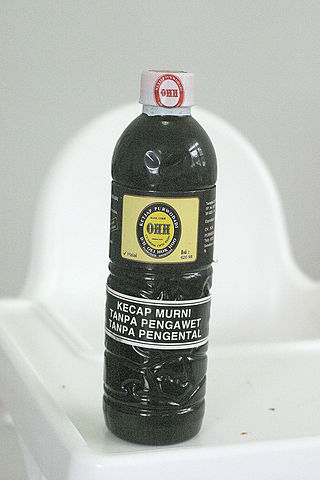
Miso is a traditional Japanese seasoning. It is a thick paste produced by fermenting soybeans with salt and kōji and sometimes rice, barley, seaweed, or other ingredients. It is used for sauces and spreads, pickling vegetables, fish, or meats, and mixing with dashi soup stock to serve as miso soup, a Japanese culinary staple. Miso is high in protein and rich in vitamins and minerals, and it played an important nutritional role in feudal Japan. Miso is still widely used in both traditional and modern cooking in Japan and has been gaining worldwide interest.

Soy sauce is a liquid condiment of Chinese origin, traditionally made from a fermented paste of soybeans, roasted grain, brine, and Aspergillus oryzae or Aspergillus sojae molds. It is recognized for its pronounced umami taste.

Tempeh or tempe is a traditional Indonesian food made from fermented soybeans. It is made by a natural culturing and controlled fermentation process that binds soybeans into a cake form. A fungus, Rhizopus oligosporus or Rhizopus oryzae, is used in the fermentation process and is also known as tempeh starter.

Nattō is a traditional Japanese food made from whole soybeans that have been fermented with Bacillus subtilis var. natto. It is often served as a breakfast food with rice. It is served with karashi mustard, soy or tare sauce, and sometimes Japanese bunching onion. Within Japan, nattō is most popular in the eastern regions, including Kantō, Tōhoku, and Hokkaido.

Kikkoman Corporation is a Japanese food manufacturer. Its main products and services include soy sauce, food seasoning and flavoring, mirin, shōchū, and sake, juice and other beverages, pharmaceuticals, and restaurant management services.

Douchi or tochi is a type of fermented and salted black soybean most popular in the cuisine of China, where they are most widely used for making black bean sauce dishes.

Aspergillus is a genus consisting of several hundred mould species found in various climates worldwide.

Doenjang or soybean paste is a type of fermented bean paste made entirely of soybean and brine. It is also a byproduct of soup soy sauce production. It is sometimes used as a relish.

Aspergillus oryzae, also known as kōji mold, is a filamentous fungus used in East Asia to saccharify rice, sweet potato, and barley in the making of alcoholic beverages such as sake and shōchū, and also to ferment soybeans for making soy sauce and miso. However, in the production of fermented foods of soybeans such as soy sauce and miso, Aspergillus sojae is sometimes used instead of A. oryzae. Incidentally, in China and Korea, the fungi used for fermented foods for a long time in the production of traditional alcoholic beverages were not A. oryzae but fungi belonging to Rhizopus and Mucor. A. oryzae is also used for the production of rice vinegars. Barley kōji (麦麹) or rice kōji (米麹) are made by fermenting the grains with A. oryzae hyphae.

Fermented tofu is a Chinese condiment consisting of a form of processed, preserved tofu used in East Asian cuisine. The ingredients typically are soybeans, salt, rice wine and sesame oil or vinegar. In mainland China the product is often freshly distributed. In overseas Chinese communities living in Southeast Asia, commercially packaged versions are often sold in jars containing blocks 2- to 4-cm square by 1 to 2 cm thick soaked in brine with select flavorings.

Rhizopus oligosporus is a fungus of the family Mucoraceae and is a widely used starter culture for the production of tempeh at home and industrially. As the mold grows it produces fluffy, white mycelia, binding the beans together to create an edible "cake" of partly catabolized soybeans. The domestication of the microbe is thought to have occurred in Indonesia several centuries ago.

Tương is the name applied to a variety of condiments, a kind of fermented bean paste made from soybean and commonly used in Vietnamese cuisine.

Meju (메주) is a brick of dried fermented soybeans. While not consumed on its own, it serves as the basis of several Korean condiments, such as doenjang, ganjang, and gochujang. Meju is produced by pounding, kneading, and shaping cooked soybeans, and undergoes fermentation with Aspergillus oryzae and/or Bacillus subtilis.

Glyceollin III is a glyceollin, a type of pterocarpan, found in the soybean. It has an antiestrogenic effect. In soil, it has an antifungal activity against Aspergillus sojae.

Jiuqu, also simply known as qu is a type of dried fermentation starter used in the production of traditional Chinese alcoholic beverages. The word jiuqu specifically refers to a type of yeast used to make alcohol such as huangjiu, baijiu and jiuniang.

Sweet soy sauce is a sweetened aromatic soy sauce, originating in Indonesia, which has a darker color, a viscous syrupy consistency, and a molasses-like flavor due to the generous addition of palm sugar or jaggery. Kecap manis is widely used with satay. It is similar to, though finer in flavor than, Chinese Tianmian sauce (tianmianjiang). It is by far the most popular type of soy sauce employed in Indonesian cuisine and accounts for an estimated 90 percent of the nation's total soy sauce production.
Aspergillus luchuensis is a species of fungus in the genus Aspergillus. It belongs to the group of black Aspergilli which are important industrial workhorses. The fungus has been used to make awamori, a distilled spirit in Okinawa Island, Japan, and is also used to make shōchū and sake. This species was first isolated and described by Tamaki Inui of the University of Tokyo in 1901. For more than 100 years there has been confusion between this species and Aspergillus awamori and Aspergillus niger with regard to scientific names and classification.

Corn sauce or fermented corn sauce is produced by fermentation using corn starch as the primary substrate. It is used as a food condiment and ingredient, both in paste and in powder form. Corn sauce, like soy sauce, has a characteristic savory taste. It is used to flavor dishes including soups, broths, and gravies.

Zygosaccharomyces rouxii is a species of yeast in the genus Zygosaccharomyces. Initially described as Saccharomyces rouxii by Boutroux in 1883, it was then moved to the genus Zygosaccharomyces in the work of Barnett et al. It is remarkably tolerant of high concentrations of sugar or salt, making it a spoilage agent of otherwise stable foods, but also present in fermentation of products such as soy sauce or balsamic vinegar.


















